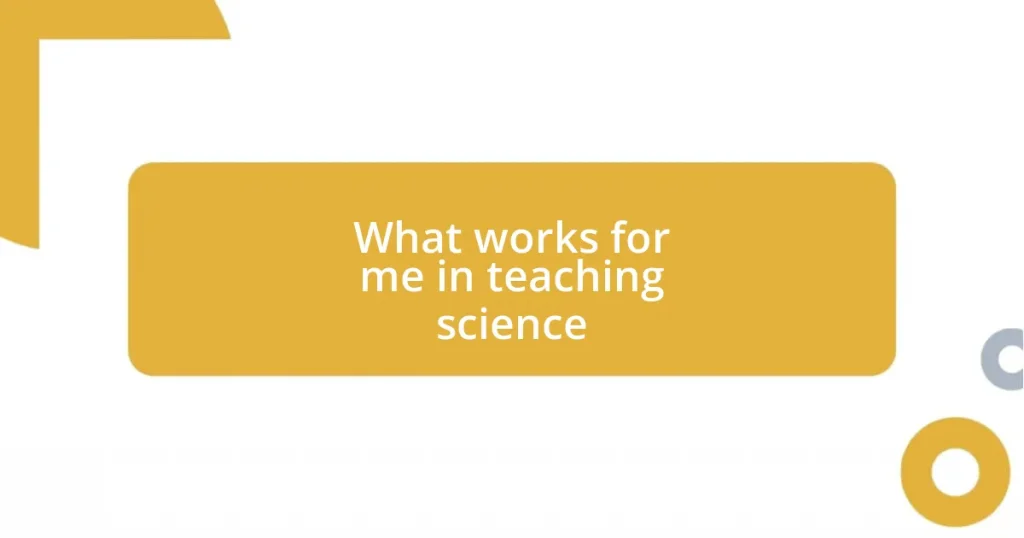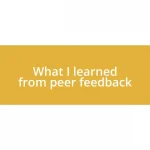Key takeaways:
- Hands-on experimentation and real-world problem solving boost engagement and curiosity in science lessons.
- Utilizing technology, such as virtual reality and online simulations, enhances students’ understanding and excitement for scientific concepts.
- Collaboration promotes deeper comprehension and essential skills like communication and conflict resolution among students.
- Adapting to diverse learning styles, including visual aids and digital presentations, fosters an inclusive and supportive learning environment.

Teaching science methods that work
One method that truly resonates with me is hands-on experimentation. I remember the thrill in my students’ eyes during a weather observation lesson when they used simple tools to track temperature changes. Isn’t it amazing how a bit of soil, water, and sunlight can spark a genuine curiosity about ecosystems?
Collaborative projects can also be incredibly effective. I once organized a group project where students created their own mini-greenhouses. Watching them brainstorm, negotiate roles, and celebrate their successes together reminded me of the importance of teamwork in science—and who doesn’t appreciate that moment when a student exclaims, “This is just like real scientists do!”?
Incorporating storytelling into science lessons adds a beautiful layer of engagement, too. I’ve found that when I weave narratives around scientific concepts, like the journey of a water molecule on Earth, students not only grasp the material better but become emotionally invested in it. Don’t we all learn better when there’s a story that connects us to the subject?

Engaging students in science
Engaging students in science requires a blend of creativity and practicality. One approach I cherish is incorporating real-world problems in our lessons. During a unit on pollution, I had students examine the litter in our school yard, leading to robust discussions on environmental impact. Witnessing them connect theoretical knowledge to their immediate surroundings created a spark of enthusiasm that was palpable.
Another technique I find effective is using technology to enhance interactivity. Last year, I introduced a virtual reality component to our biology curriculum. Students immersed themselves in a 3D cellular environment, exploring cell structures as if they were tiny scientists themselves. The sheer joy and excitement on their faces as they navigated through the cell membranes made it clear: when students can visualize scientific concepts in a fun way, their engagement skyrockets.
Additionally, I’ve learned that fostering a growth mindset is instrumental in keeping students engaged. I often share stories of famous scientists who faced failures before breakthroughs. Recently, I told my class about Thomas Edison and his many unsuccessful attempts at creating the lightbulb. Relating moments of struggle to scientific discovery not only inspires students but also builds resilience in their own learning journeys.
| Engagement Method | Personal Insight |
|---|---|
| Real-World Problems | Real connections lead to excitement. |
| Technology Integration | Virtual experiences enhance understanding. |
| Growth Mindset | Inspiration from failure builds resilience. |

Incorporating hands-on experiments
Incorporating hands-on experiments into science lessons gives students a tangible connection to the concepts we cover. I’ll never forget the excitement during a simple pH experiment with cabbage juice—my students were amazed to see the color change as they tested different household liquids. It was as if their curiosity awakened anew, and they began to ask questions that I hadn’t anticipated. That moment encapsulated the magic of learning through experimentation: when students engage their senses, their understanding deepens and flourishes.
- Hands-on experiments bolster active learning, enabling students to become the scientists they aspire to be.
- Observations made during experiments promote critical thinking and dialogue among peers.
- Engaging in trial and error helps students embrace the scientific process, learning that mistakes are merely stepping stones to discovery.
When I designed a series of science stations around building circuits with simple materials, the buzz in the classroom was electric—pun intended! Students raced to share their discoveries, displaying a genuine eagerness to learn from each other. I realized that these experiments not only cultivated enthusiasm but also nurtured collaboration. The joy of conquering a challenge together is something I strive to foster, creating a community of young scientists who support one another in their explorations.

Utilizing technology in science teaching
In my experience, technology can transform the way students approach science. For example, when I introduced online simulations to illustrate complex concepts like chemical reactions, I noticed an incredible increase in curiosity. The students eagerly experimented with different variables, asking questions that they’d typically shy away from in a traditional lecture setting. Isn’t it fascinating how the digital world can open doors to exploration that we couldn’t have imagined just a decade ago?
Another memorable instance was when we used data visualization tools during our ecology unit. Students collected data from local ecosystems and presented their findings using interactive graphs. Seeing them engage with real data not only made the subject matter more relevant but also helped develop their analytical skills. It’s moments like this that remind me of the power of technology in creating a deeper understanding of scientific inquiry.
I’ve also experimented with social media as a learning tool. Once, I set up a class Twitter account where students shared their daily science observations and participated in science-related discussions online. It was incredible to watch them take ownership of their learning and communicate their findings creatively. How often do we forget that learning can happen outside the four walls of a classroom? By leveraging technology, I’ve seen firsthand how we can extend our classroom into a boundless space of discovery.

Promoting collaborative learning
When I integrated group projects into my science curriculum, the room buzzed with energy and enthusiasm. One particular project involved students creating their own experiments to study plant growth under different light conditions. Watching them divide responsibilities, debate the best approach, and collaborate on their presentations was like witnessing a symphony in motion. It became evident that when students work together, they not only learn from the material but also from each other, fostering a deeper comprehension of scientific principles.
There are times when I’ve been pleasantly surprised by the creativity that emerges through collaboration. During a unit on ecosystems, I assigned each group a specific biome to research and present. One group decided to turn their findings into a skit, complete with costumes made from recycled materials! Not only did this make the learning process enjoyable, but it also pushed the boundaries of how they expressed their understanding. Have you ever seen the confidence that builds in students when they share their unique contributions? It’s a beautiful merging of creativity and science.
I find that collaborative learning goes beyond just completing a project; it nurtures vital skills like communication and conflict resolution. Just the other day, two students had a disagreement about their findings during a lab experiment. Instead of stepping in immediately, I observed from a distance. They ultimately came to a consensus by discussing their different viewpoints, which reinforced my belief that these moments are crucial for personal growth. Isn’t it amazing how collaboration in science not only enhances academic understanding but also shapes character?

Assessing student understanding effectively
Effective assessment of student understanding is a process that goes beyond traditional testing methods. I remember a time when I decided to use exit tickets at the end of a class. Each student wrote down one concept they grasped and one question they still had. It was enlightening to see not only what they understood but also how their minds were actively engaged in the learning process. Isn’t it rewarding to receive such direct feedback from students?
I’ve also found that verbal assessments can reveal so much more than a written exam. For instance, during a lab session, I would ask students to explain their thought process as they conducted experiments. Their explanations often uncovered misconceptions and provided insights into their reasoning. It truly highlighted how much more I could learn about their comprehension through dialogue than through a simple grading rubric. Have you ever had those moments where a student’s explanation made you see the topic in a completely new light?
Moreover, incorporating peer reviews into my assessment strategy has proven incredibly beneficial. I encouraged students to critique each other’s work after collaborative projects, which fostered a culture of constructive feedback. I was taken aback by how much they learned from each other—not just the content, but also the importance of perspective in science. This approach not only bolstered their understanding but also created a supportive classroom environment where they felt valued. Isn’t it fascinating how peer interactions can deepen their learning experience?

Adapting to diverse learning styles
Adapting to diverse learning styles is essential in creating a truly inclusive science classroom. I vividly recall a lesson on the water cycle, where I used a mix of visual aids, hands-on activities, and storytelling to reach every type of learner. While some students thrived during the interactive simulation of evaporation and condensation, others connected deeply through the narrative I wove about water’s journey. Have you ever noticed how a simple shift in approach can ignite a spark in a student’s eyes?
One approach that has consistently amazed me is the integration of technology. When I allowed students to create digital presentations instead of traditional reports, the results were nothing short of impressive. One shy student, who usually preferred to keep to themselves, flourished as they designed an animated video about the solar system. It reminded me that when we embrace different formats, we unlock hidden talents. Isn’t it incredible how technology can bridge gaps in understanding?
Listening to students’ feedback about their learning preferences has also transformed my teaching methods. One day, after a lab that just didn’t resonate with a few students, I gathered their thoughts. They expressed their preference for more visual elements. Taking that to heart, I integrated more diagrams and videos in subsequent lessons. It’s moments like these that reinforce my belief in the power of adaptability. Don’t you think that attuning our teaching strategies to our students’ preferences fosters a richer learning experience?















